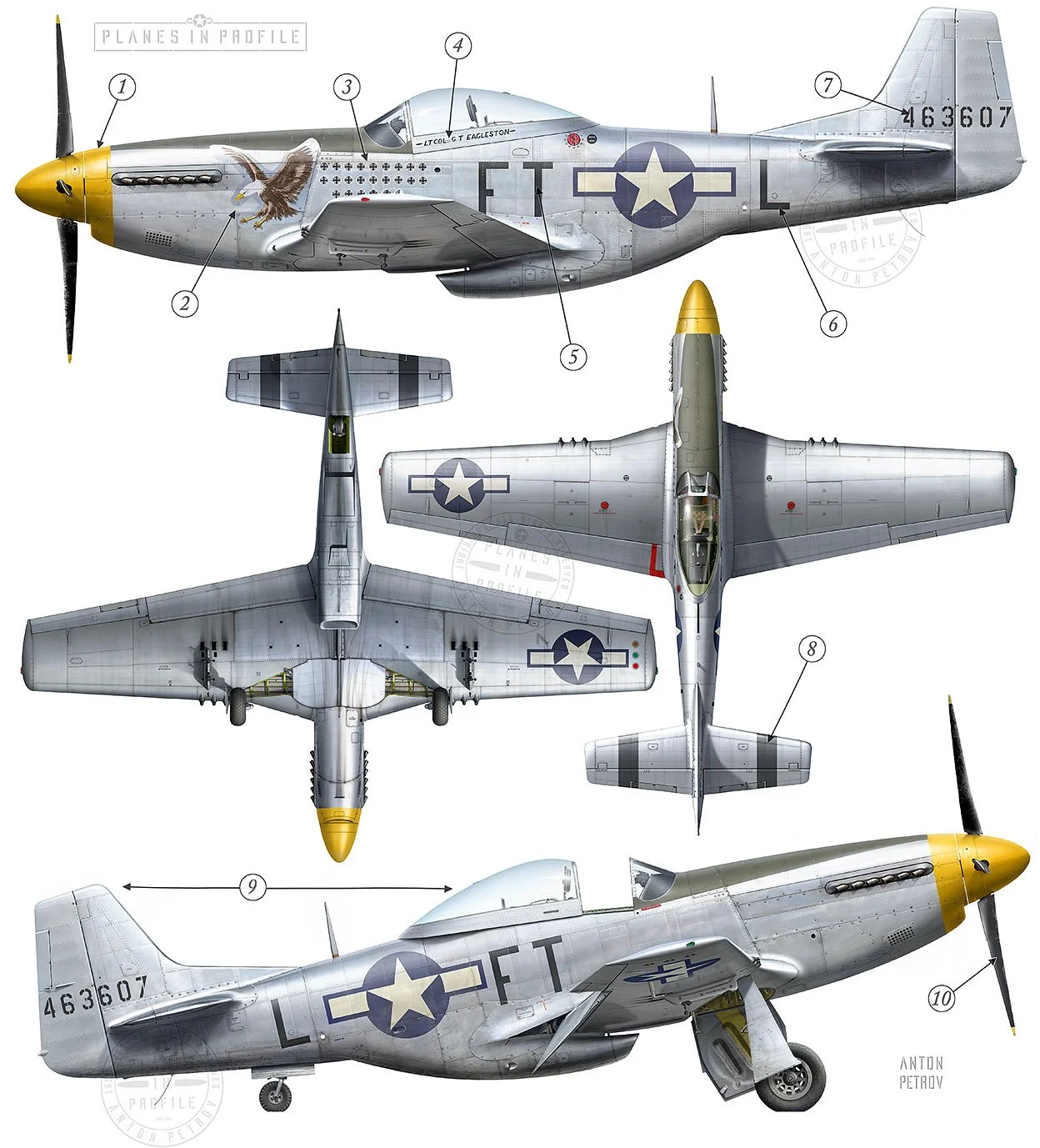Eagleston’s “Feeble Eagle”
North American, P-51D-20NA (Mustang), Serial number 44-63607
353rd Fighter Squadron, 354th Fighter Group “Pioneer Mustang Group”, 9th Air Force,
Rosieres-en-Haye (A-98) (France), Ober Olm Airfield(Germany)(Y-64), Ansbach (Germany)(R-45), AAF Station Herzogenaurach (R-29)(Germany). March 1945 to End of the war.
Flown by the commander of the 353rd FS, Lt.Col.Glenn Todd Eagleston (Eagle), an ace with 23.5 victories.
44-63607 as it appeared around mid-April, 1945, at the Ober Olm airfield (Germany). Note the 20.5 victories on the side of the airplane. These include Eagleston’s 18.5 aerial kills and evidently 2 ground kills.
G.T. Eagleston was 354th FG’s leading ace, whose abilities and achievements earned him the “fighter pilots’ fighter pilot“ epithet. The 22 year old Eagleston took command of the 353rd Fighter Squadron in October 1944. At that time, after flying P-51B Mustangs, the group was temporarily equipped with P-47 Thunderbolts. However, on February 16th, 1945 Eagleston’s squadron was re-equipped with Mustangs once again, this time with P-51Ds. Eagleston was assigned the Mustang with serial number 44-63607, which, like his previous plane, became adorned with an image of an eagle. An airplane that many today refer to as the “Feeble Eagle”. It was the last airplane assigned to Eagleston in WW2. Eagleston ended the war with 18.5 victories, 2 probable victories, and 7 damaged German aircraft, plus at least 5 enemy aircraft destroyed on the ground, making him the leading ace in the 9th Air Force in WW2 [1]. Out of these victories, the last 2 were achieved from behind the controls of the “Feeble Eagle”.
March 15 1 x Fw-190 Bad Homberg (Germany)
March 25 1 x Me-109 10m SW of Aschaffenburg, near Neustadt (Germany).
The victory on the 15th of March occurred at 11:20 in the morning. The 353rd FS’s Mustangs spotted a group of Fw-190s about to bounce a lone P-38. Climbing to head off the attack, the P-51 pilots shot down two enemy fighters, one of them fell to the guns of the “Eagle”. [2]
The victory on the 25th occurred while flying a patrol sortie in the area of Frankfurt, Germany. Two Me-109 were flying toward the bridgehead area, and Eagleston turned, tacking onto the tail of the rear aircraft. A one-second burst from thirty degrees was all it took to slow the aircraft. A second burst from dead astern started it smoking, and the pilot bailed out. [3]
44-63607, as it looked in May, 1945 at Ansbach (Germany)(R-45) and/or AAF Station Herzogenaurach (R-29)(Germany. Note the three extra victory markings on the side of the airplane. These were evidently 3 ground kills.
G.Eagleston remained in the airforce after the war, flying various other airplanes. He went on to destroy 2 more (+1 probable) and damage 7 more enemy fighters during the Korean War.
Noteworthy Visual Characteristics
1) Yellow colour (appearing on the nose) was the identification colour 353rd Fighter Squadron within the of 354th FG.
2) The eagle was painted on more than one of Eaglestone’s airplanes. Some sources say that “Eagle” was Eagleston’s nickname and that the first airplane to have the eagle painted on it was called the “Feeble Eagle”. Many sources on the internet refer to the airplane shown on this page as the “Feeble Eagle” too.
The background colour behind the eagle artwork is a source of mystery. Some profile artworks show it as yellow, white, or blue. When looking at some b/w photos, the tone of eagle’s background appears to have high contrast in the areas reflecting the light. In addition to this the tone appears to be similar to the surrounding metal on which the art it’s painted. It’s possible that this background colour was actually painted with silver/aluminum paint, similar to some of the other parts of the airplane.
3) Eagleston’s victories were represented by a Balkenkreuz over a white circle. There were 23.5 of these eventually painted on the side of 44-63607, 18.5 were aerial kills the rest (5) were evidently ground kills.
4) The name of the pilot was painted on the canopy frame, -Lt.Col. G.T.Eagleston-. He was promoted to Lt.Col. on March 23rd, 1945.
5) “FT” was the letter code of the 353rd Fighter Squadron.
6) “L” was the identification code of Eagleston’s Mustang. His previous plane, a P-47, was also coded “L”.
7) 463607 represents the plane’s serial number 44-63607
8) On Patreon
9) It looks like there was no antenna wire.
10) Note that the propeller didn’t have any of the usual branding and tech-markings on it.
FOOTNOTES
[1] Based on the info on https://web.archive.org/web/20160328141435/http://www.hill.af.mil/library/factsheets/factsheet.asp?id=5808
[2] Based on the information from the book ‘354th Fighter Group’, by William N. Hess, published by Osprey Publishing in 2002, pages 111, PDF e-book ISBN:978 1 78200 894 1
[3] Description of the last victory is from ‘P-51 Mustang Aces’, by William N. Hess and Thomas G.Ivie, published by Motorbooks International in 1992, page 131, ISBN 0-87938-530-8
SUMMARY OF LINKS TO THE REFERENCE IMAGES AND/or VIDEOS
https://www.americanairmuseum.com/archive/media/media-52016jpeg
https://www.americanairmuseum.com/archive/media/media-52017jpeg
https://www.americanairmuseum.com/archive/media/media-52019jpeg
https://i.pinimg.com/originals/d0/58/b3/d058b35f0f9597f54418f426d0f20d85.jpg
https://i.pinimg.com/originals/d2/a1/ec/d2a1ec706187e4e9554f27bcb960928e.jpg
http://www.354thpmfg.com/images/img/portfolio/single/mftriventi/mft-image-40.jpg
All the work presented on this page is subject to updates and revisions in the light of new information which might present itself. If you have any new information relevant to this page or disagree with anything that's presented here, then please contact me through the Planes in Profile Facebook page to help make the content of this page more accurate. Thanks:)



